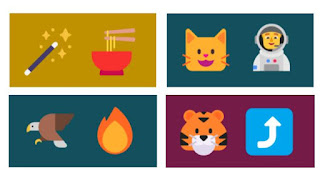Origami in our library
Why origami?
- It is active! Active nonfiction books guide students through DOING something. It has a different feel from most books that share facts.
- It supports literacy - both spatial and the traditional literacy. Origami encourages reading through the visual appeal of the pages - no heavy text is required to read to be successful. Captions or short directions do the trick. Short spurts make students feel successful!
- Leadership! Student leaders will emerge from the group and become "coaches" for the others. It is often the least likely candidate who will lead these groups.
- Paper knows no language barriers. Students can sit side by side and fold together despite the fact that they do not speak the same language. Folding is its own language!
- It is practically FREE! Students can borrow a book and grab a stack of paper to take home and create.
How?
- Access - Provide the books (see resources below)
 |
| Clear labels point students to what they are looking for |
- Access - Provide the paper. Traditional origami paper isn't cheap, but copy paper and recycled books are! I taught students how to turn 8 x 11 sheets of paper into squares. I also have library volunteers cut recycled book pages into squares. I keep a bin of origami paper on the circulation desk. Students are welcome at any time to come grab what they need. I can't assume my students have access to paper or scissors at home but I CAN make ready-to-go paper available in our library by recycling book pages. *Weird But True books are well loved and conveniently SQUARE! They make the BEST origami paper because no cutting is needed and they are also wonderfully fascinating to read as you fold!*
 |
| This well-loved Ripley's Believe It Or Not is destined for someone's origami project. The colored pages are beautiful (and fascinating)! |
- Integrate it - it more than likely won't take off on its own. With a little prompting, it may take on a life of its own though....
.JPG) | ||
We read Amy Wu and the Patchwork Dragon for Read for the Record 2022 and created origami dragons
|
- Vocabulary: To develop origami vocabulary and confidence, begin with simple creations. We started with corner bookmarks. They can become anything!

Red Ted Art has great suggestions - a simple corner bookmark can become anything!
My takeaways
Resources
Further reading
How we got here
"Mrs. Garland, I need more origami paper!"
Students in our library know where the origami books are and know where to find paper to take home for creating. They will often stop by the library just to pick up some extra paper.
This wasn't the case of an overnight sensation, rather a slow burn. It started YEARS ago as I was bringing an aged nonfiction section back to life. The crafter and engineer in me thought updating the few yellowed, text-heavy origami books might bring some excitement to a sleepy section of the collection.
These books didn't just fly off the shelves and generate excitement for origami. They sat. And I considered how those purchases could make an impact in our library.
My first step was to incorporate origami IN our library. At the time, I was running an "Open Library" during recess. Students could come to the library for Makerspace as an alternative to recess. This is where I learned. I sat with students. We folded, we failed, we figured it out.
Next, I put simple colored sets of directions on the tables and opened up an origami station during library time. Again, these tables where heavily populated and the books started to circulate.
It was only when I started to provide video directions (QR codes & iPads) that origami REALLY took off. I feel like the videos really helped students to SEE the steps and give them some confidence. With some basic skills and confidence under their belts, origami took off.
The books were circulating! Kids were excited! And then....
"But Mrs. Garland, I need paper!" OF COURSE!
But.... origami paper is expensive! Once we depleted the existing packages, I taught students how to make square paper out of copy paper (fold a triangle and cut the end off). However, this was assuming they had paper and scissors at home (not an assumption I can make). Here is where our volunteers stepped in. Over the years they have cut copy paper, note pads donated by a local dermatologist, and ultimately book pages! Yep, our favorite origami paper is paper from books that have seen better days. We can't read the books anymore, but we surely can recycle the pages and turn them into something amazing!








Comments
Post a Comment